When you’re trying to sell your house, what’s the first thing potential buyers will be looking at?
You’ve got it – the front. It’s what realtors call “curb appeal.”
If we apply this to your website, what’s the first thing visitors will usually take note of when they visit you online? If you said your homepage, you’re bang on.
Your homepage is critical. It sets the tone for the entire experience, and gives visitors an immediate sense of who you are, what you offer and why they should choose you.
It only makes sense, then, that your homepage be in tip-top shape.
But, in making your homepage the best it can be, it’s important to not overlook the copy. While it’s easy to get fixated on improving the design of your website, the copy (aka the words) is equally — if not more — important.
In this article, learn why your homepage copy matters, what makes for stellar homepage copy, how to get started using two popular formulas, and some examples to get you going.
Let’s dive in.
Why Does Your Homepage Copy Matter?
It takes visitors approximately 0.05 seconds (that’s half a second) to form an opinion of your website.
Readers only consume 20% of the content on a page.
And 57% of visitors won’t recommend a business that has a poorly designed website.
That means you have mere seconds to make a strong first impression, and you usually only get one shot at it.
It comes with little surprise, then, that you need to provide everything your visitors want, right away. Keeping it clear and concise is the key.
Your homepage is the entry point to your virtual presence. It’s your curb appeal, your online storefront. And so it needs to shine, because it can make or break your business.
What is Homepage Copywriting?
ou might be surprised to learn that many people don’t know what copywriting is, let alone homepage copywriting.
Robert W. Bly wrote in his book, The Copywriter’s Handbook that a “copywriter is a salesperson behind a typewriter.” While we don’t use typewriters anymore (well, most of us don’t), the sentiment still stands – copywriting is writing for the express purpose of selling something.
This may not be selling in the traditional sense, as in the case of nonprofits, public personalities, etc. But copywriting is all about moving your audience to take action, whether that’s buy from you, hire you, donate to your charity or join your community.
That means copywriting is not:
- Content writing (though content writing often draws on copywriting techniques for things like headlines and CTAs)
- Journalism
- Legal trademarking (that’s copyrighting)
When we talk about copywriting for website homepages then, there are a few specific things to consider before you get started:
- How are you going to immediately capture your visitors’ attention?
- What is the overall tone you want to convey?
- What are you going to use to establish your credibility and authority?
- What emotions do you want to appeal to?
- How does your copy pair with your design?
Copywriting is as much about strategy as it is about actually writing. Taking a moment to review these questions with your team can help get you started with your homepage copy.
What Copy Usually Goes on a Website Homepage?
While we’ve given a brief overview of what a homepage is, let’s look at one in more detail and explore what kind of copy typically goes “above the fold” and “below the fold” on a homepage.
For a brief definition, a website homepage is the introductory page that visitors will usually click through to as an entry point to your website.
(The exception to this rule is: if a visitor is coming from an ad, it’s smart to direct them to a landing pages as opposed to your homepage).
Here’s an example of the top portion of our homepage, here at Sparked:

What you see here is the first impression a user gets when they click on our website.
Since this portion of the homepage typically fills the user’s screen upon entry, it’s refer to as the portion that’s “above the fold”.
As the user starts to scroll, they will discover the content that’s “below the fold”.
On a homepage, every word counts. That’s why it’s important to be intentional about what copy you’re putting above and below the fold.
What Copy Should Go Above the Fold?
You’ll notice from our example above, the copy that’s above the fold is trim, concise, and tells visitors exactly what benefit they’ll get from engaging with us.
Content that’s above the fold will typically include what’s called a “hero” image and headline that clearly states your value proposition.
Here at Sparked, we solve our clients’ biggest digital marketing challenges, so we state that in the hero, and show a picture of someone who could be our client.
Pro copywriting tip: It’s important to keep the spotlight focused on the reader, and not on your business. This shows you understand your prospects’ problems or pain points.
So rather than say “We do x, y or z”, reframe the language to make it about how the prospect will benefit.
For instance, in our example, we could have said, “We solve digital marketing problems,” but instead we reframed it to “Solve your digital marketing problems”. See how when we make this simple shift, it’s no longer about us, but rather about the reader?
If you want to learn more about keeping the spotlight on the reader, check out this helpful video on the topic from Marie Forleo.
What Copy Should Go Below the Fold?
Below the fold refers to all of the content that comes next on the homepage, after a user starts scrolling down.
Here’s an example of what our website looks like below the fold, upon first scroll:
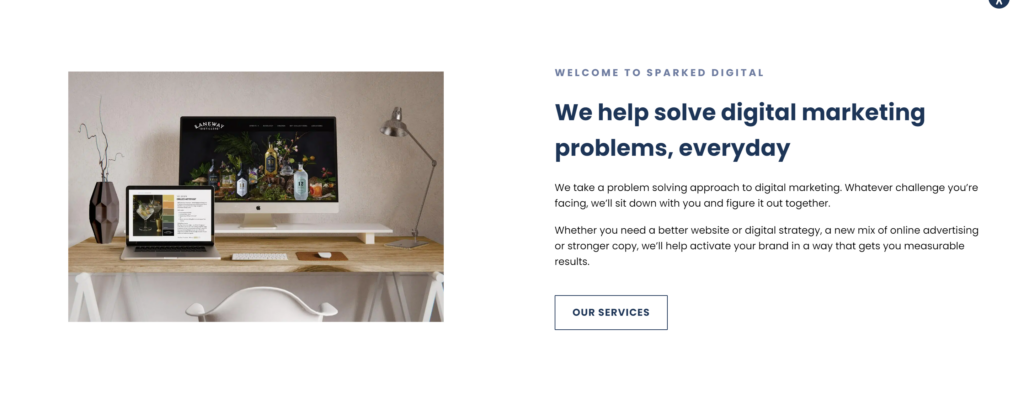
When we move below the fold, we start to see more text. Carefully curating this text into concise language that’s a bit more in-depth than what you have above the fold will help unfold your story for your visitors.
It’s common to provide a series of benefit statements that match up with the services you offer, or show your prospect how they will win by choosing you.
Of course, your homepage probably won’t stop there. As the user continues to scroll, you’ll want to introduce your key products or services, provide navigational links to other sections of your website, offer social proof that backs up your claims, and include a clear call-to-action (CTA).
How to Write Effective Homepage Copy Using Formulas
Crafting the perfect copy for your homepage isn’t a one and done. It can take time, testing, and iteration. But it’s worth the effort.
To get started, it’s helpful to rely on a copywriting formula. Copywriting formulas are used by many copywriters to bring an effective structure and framework to their copy. It’s like using a template you can fill in.
The two most popular formulas are known as AIDA (attention-interest-desire-action) and PAS (problem-agitation-solution). Let’s take a look at each.
AIDA
The AIDA (attention-interest-desire-action) formula is common and you’ve probably seen it everywhere – from online ads to sales pages to homepages. AIDA includes:
- Attention: Grab the reader’s attention with a compelling headline.
- Interest: Create interest for the reader by telling them how they can benefit from your services or products.
- Desire: Cultivate desire by showing them how others have benefited and why taking action is a good idea.
- Action: Finally, call them to action. Common examples are “Contact us”, “Get a free quote today”, “Buy now”, “Donate today”, and so on.
Here’s an example of the AIDA formula in action from payroll platform company Wagepoint. We’ve shown part of their homepage here, but check out their website to see the whole thing.
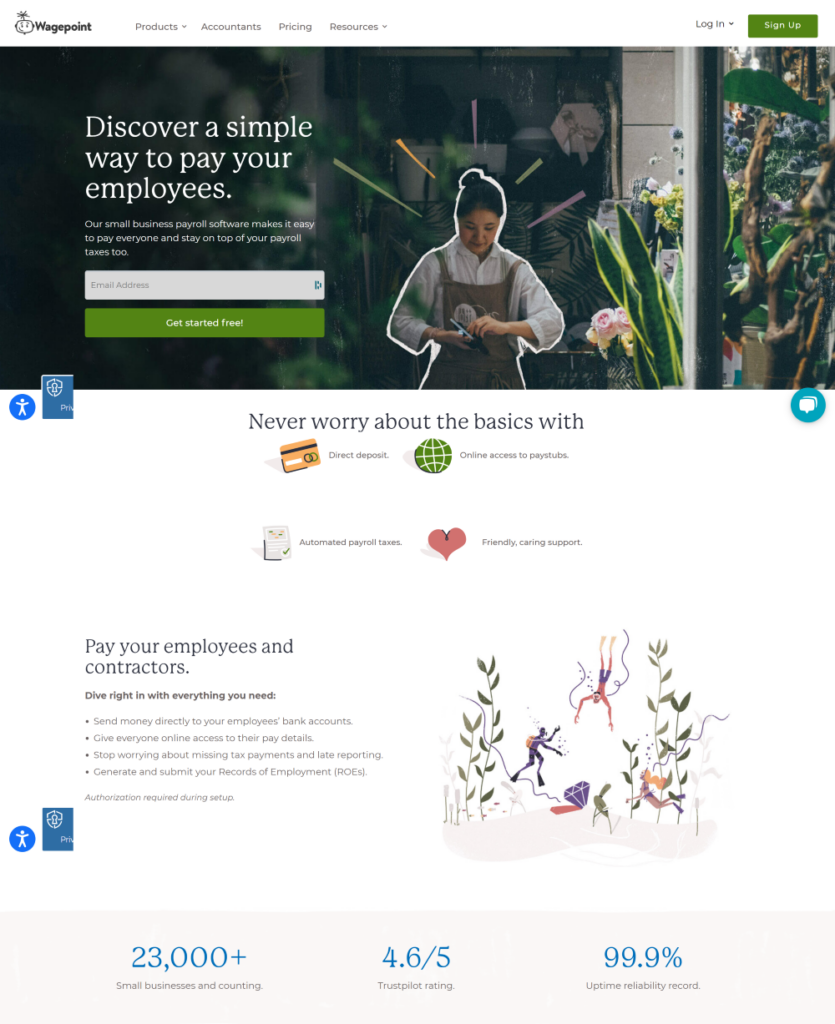
In this example, Wagepoint is using AIDA by:
- Grabbing attention with a clear headline that appeals to their target audience (“Discover a simple way to pay your employees”);
- Creating interest by explaining how it will benefit users (“Never worry about the basics.” And “Dive right in with everything you need.”);
- Cultivating desire by showcasing how many other people are using it (“23,000+ small businesses and counting”) and its rating (“4.6/5 Trustpilot rating”); and
- Calling the reader to action (“Sign up”).
PAS
PAS (problem-agitation-solution) approaches things a little differently. It’s centered around identifying a pain point, and it works because the reader makes the mental leap that if you can describe their problem deeply, you probably also know the right solution for them.
PAS includes:
- Problem: Identify your audience’s problem.
- Agitation: Now, agitate that problem. Describe how it feels, what it means, or why it’s so difficult. Here it can be helpful to bring out the emotional aspects of their pain or problem.
- Solution: Finally, introduce the solution. Show them how your business can help them overcome their problem. And make sure to call them to action.
Here’s an example of the PAS formula in play from project management platform company Basecamp. Again, we’ve captured part of their homepage here, but head to their website to view the whole thing.
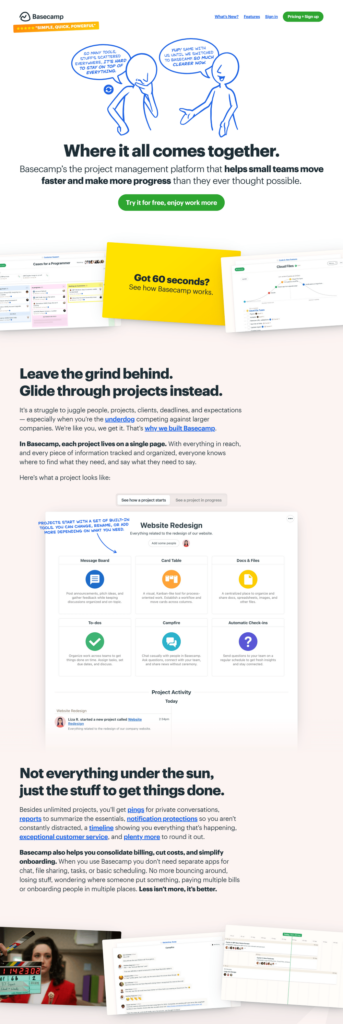
You can see in this example that Basecamp clearly:
- Identifies their target audience’s problem (“So many tools, stuff’s scattered everywhere, it’s hard to stay on top of things”);
- Agitates the problem by describing how it feels to experience it (“It’s a struggle to juggle people, projects, clients, deadlines, and expectations — especially when you’re the underdog competing against larger companies”); and
- Introduces their platform as the ideal solution (“Basecamp’s the project management platform that helps small teams move faster and make more progress than they ever thought possible”).
For more copywriting formulas, check out this massive list of copywriting formulas from Joanna Wiebe at Copyhackers.
5 Copywriting Best Practices for Your Homepage
Now that we’ve covered why homepage copywriting is important, and listed some copywriting formulas to get you started, it’s time to talk about homepage copywriting best practices.
We’ve compiled a list of 5 tips to help you with your homepage copywriting. There are many more than these, but here are the most important.
1. Know Your Audience
This is basically marketing 101 – know your audience. This also means knowing their needs and behaviours.
Does your audience skim quickly on their phones while on their way to work, or do they look at your website while sitting at their desk? Are they aware your solution exists, or are they still researching options? What problem are they trying to solve, and how will they feel when they succeed?
It comes as no surprise that what goes into your homepage will depend on your understanding of your customer.
For example, a website that offers a SaaS product (software as a service) might be skimmable (sparse text; image heavy) until further below the fold as most visitors will be wanting a quick sense of what the software interface looks like.
Whereas, a website for visitors who are already primed and are expecting detailed information can be a bit more text heavy.
Check out this example from BetterHelp. It’s clear they knows their audience, and have invited them to choose their path:

2. Keep It Simple
Short and sweet is how we like it over here in the copywriting world. Especially on your homepage.
Don’t over complicate things. Avoid getting deep into the technical details. Don’t use puns or language that you think is smart or obscure. Simple, clear and concise wins every time over language that readers have to decode.
Getting right to the point will help make your homepage impactful, and your visitors will appreciate it. They’re busy, too.
Here’s an example of a homepage from Wealthsimple that nails it. Simple, clear and extremely effective:

3. Write How You Speak
Once you’ve written your homepage copy, read it out loud.
How does it sound? Natural or robotic? Smooth or choppy?
Human brains like familiarity and if your copy doesn’t sound natural, it may be off-putting.
You can also break some of those high school grammar rules.
For instance:
- Always use contractions (e.g., can’t instead of cannot, or we’re instead of we are). Contractions are easier to read.
- Don’t be afraid to begin your sentences with “and” or “but” for emphasis.
- Sentence fragments are totally fine – so long as they’re done intentionally and occasionally.
Here’s an example of what we mean, from Later. Notice how they use language their audience would probably use themselves (like “Crush your social goals”):

4. Break up the Text
Similar to the point above, having all your copy in one block of text won’t get you very far. It won’t matter if your copy is excellent, if it’s a single block, you’ll be lucky if visitors read it.
Why? Well, website visitors are skimmers.
Even long-form writing will most likely get skimmed, especially when visitors are using their mobile devices.
When it comes to your homepage copy, breaking up the text will keep your visitors engaged. Want to take it a step further? Create variation in text size and boldness, and include some bullet points.
Check out this great example from Quickbooks:
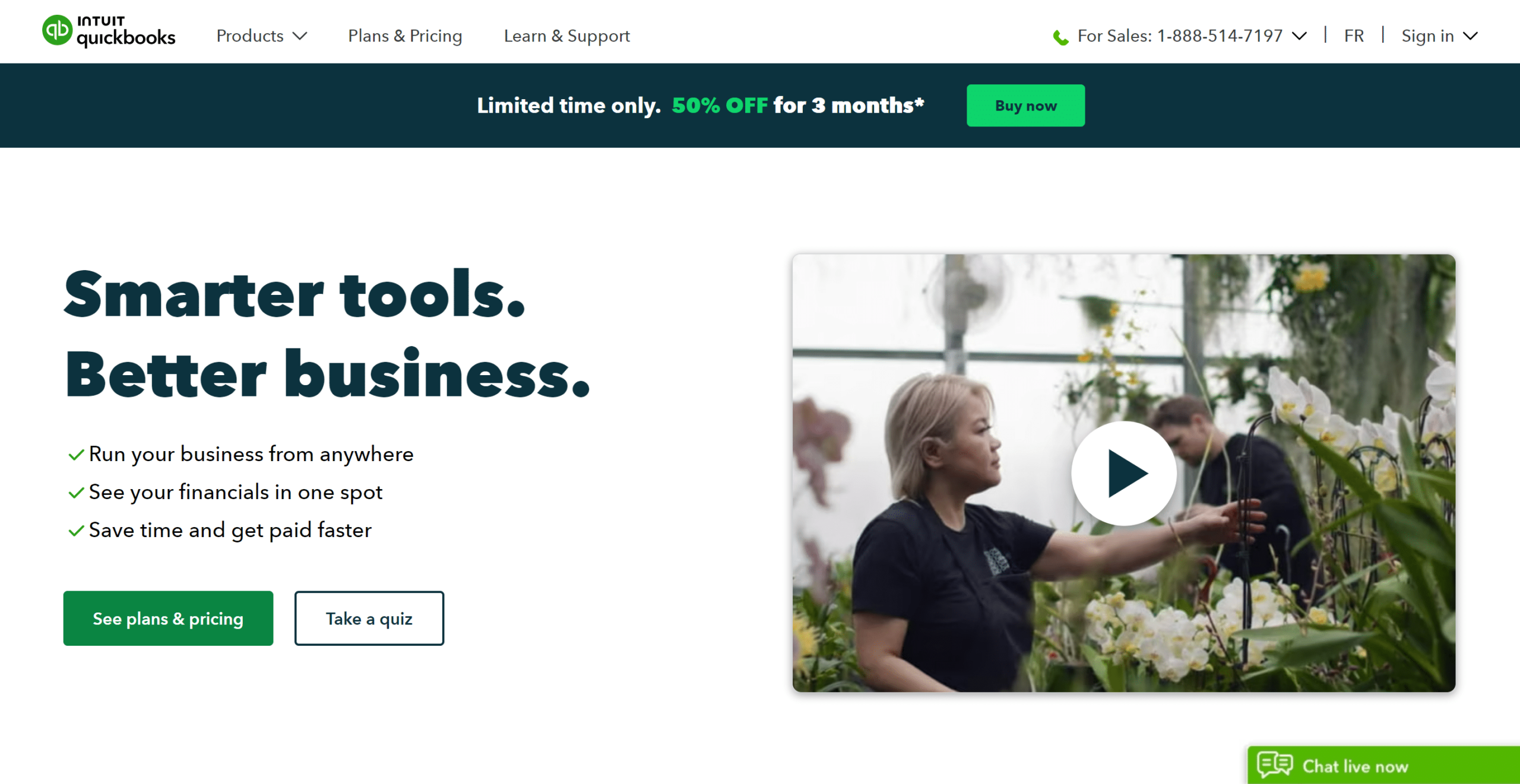
5. Keep It Active and Actionable
We’re going to go back to your high school English days again: active voice.
Active voice is when the subject of the sentence performs the action (e.g., subject-object-verb).
Conversely, passive voice is when the action is performed by the subject (e.g., object-verb-subject).
For example, “she wrote a blog post” is an active sentence. The passive variation of this is, “a blog post was written by her.”
Which one sounds: a) simpler; b) easier to understand; and c) feels more engaging?
You got it, the first one.
Always keep your language active. It creates a sense of clarity, simplicity and interest.
And, on that note, keep it actionable. What do we mean by this? Well, you want your visitors to feel empowered to take action, right? This means a call-to-action. It could be a “contact us” button or a “download your free eBook here” option.
Here’s an example of a website from Maple that does this well:
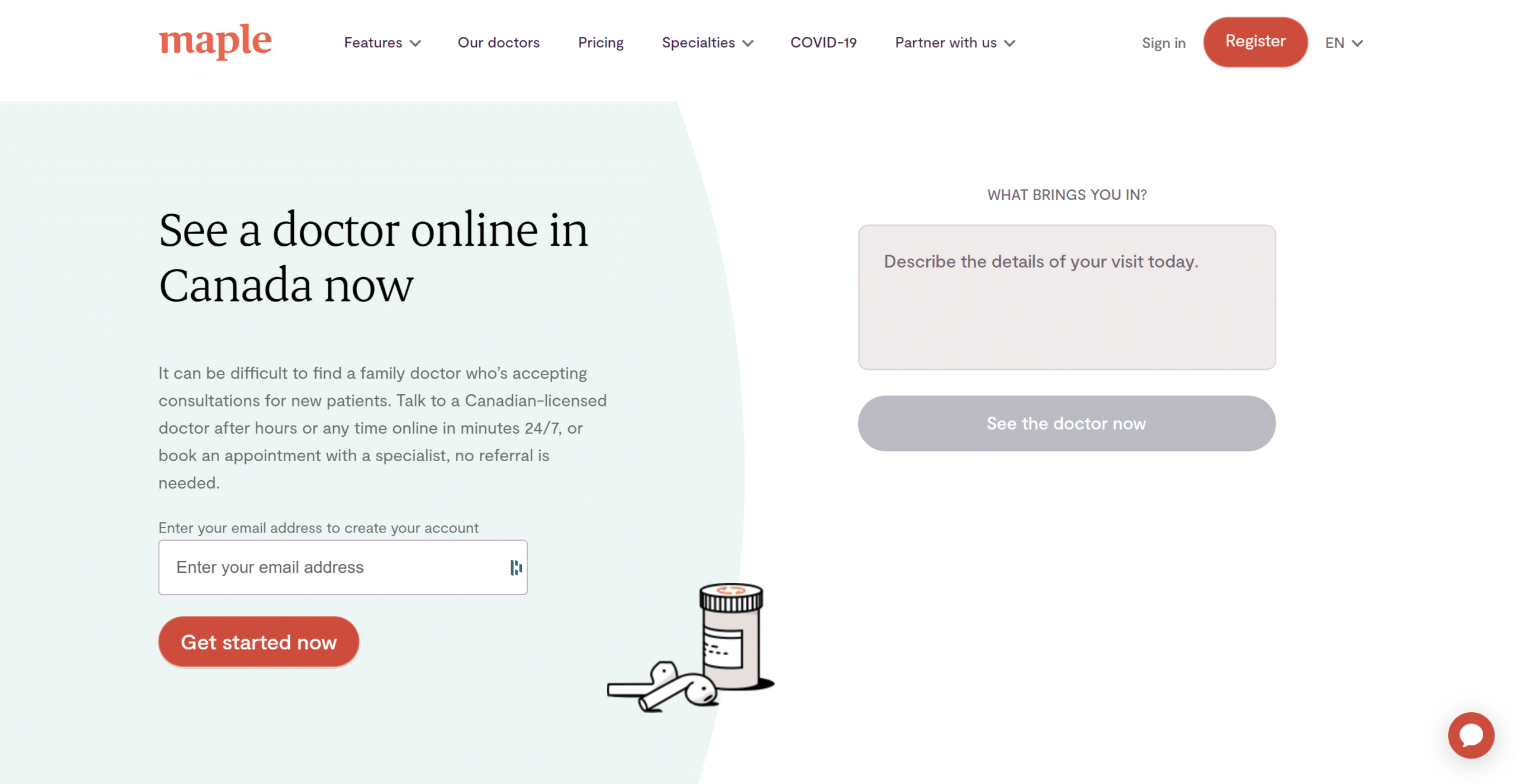
Bring Your Brand to Life with the Right Homepage Copy
Want to implement these tips, but don’t know where to start? Working with a professional copywriter can make a world of difference. At Sparked, we are far from simply wordsmiths. We’re your strategic partners.
Find out more about our copywriting services, or contact us today to see how we can help you shine online.




